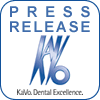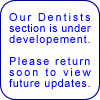Introducing
Diagnodent
published in The
Grapevine Jan 1999
by Dipak Joshi |
|
 |
|
Practitioners
I suspect, have always been aware, but somewhat detached,
to the possibility of “hidden carries” lesions
in our patients. A sudden traumatic encounter with a collapsed
occlusal surface of a permanent first molar prompted our
practice to review our diagnostic procedures. We started
using the Diagnodent in the summer of this year and since
then there has been a significant change in our approach
to the treatment of children. We have had to purchase
a new range of materials.
This article summarises the changes that resulted from
the introduction of Diagnodent into our general practice. |
Examination
After a little initial practice, we found the Diagnodent easy
and very quick to use. After drying the teeth and explaining
the “new toy” to both the parents and patients,
we were able to scan the fissure patterns quickly. We were
amazed at the number of positive readings that we encountered.
(I would estimate that the detection rate of Diagnodent was
over double the normal scoring). Initially we would cross
check the readings by displaying the tooth on the intraoral
camera. Only then, at x40 magnification, a characteristic
“halo” of decalcified enamel around a stained fissure,
was quite often revealed.
Charting
Since it is quite common to find more than one lesion within
a single fissure pattern, it soon became apparent that we
would need to change our charting method. We now note both
the numerical value and the precise location within each tooth’s
fissure pattern. The system has been shown to generate a quantitatively
reproducible measurement and can detect undermining caries
up to a depth of 1mm. Because the Diagnodent can detect early
lesions and the readings are reproducible, the following options
for treatment are possible.
Treatment
With experience it is possible to guage the depth of the problem
(no pun intended) from the numerical scale. KaVo are producing
guidelines based on these numeric values.
From 00 to 20 probably very early enamel decalcification present
(just visible with the magnification of an intraoral camera,
at the high numbers).
Treatment regimes would be concentrated on preventive therapy,
to include oral hygiene dietary instruction and the use of
fluoride-based mouth rinse gels and, recently introduced foams
to encourage re-mineralisation. It is now possible to monitor
the lesions, as the mearsurement is reproducible. This significant
advance removes the guesswork and allows us to apply preventive
therapy with a degree of confidence and a considerable reduction
of risk.
From 20 to 40 enamel lesions are probably sufficiently advanced
to warrant minimal invasive treatment i.e. micropreparations
using “sealant restorations”. We use “Ultraseal”,
Optident Ltd. Their well-designed application system is particularly
suited for this type of treatment. The other materials include
Fuji II LC Glass lonomer and “Revolution” flowable
composite with “Optibond FL” from SDS-Kerr. As these
lesions are often located in the enamel only, treatment can
be provided without the use of a local anaesthetic. A fact
appreciated by both the child patient and their dentist! Sometimes,
a much greater dentinal spread is present.
A check radiograph is advised. I must stress that these are
personal observations. However, I am encouraged to note that
KaVo is currently working on a clinical guideline for distribution.
They also intend to support the practitioners by designing
and producing supporting literature for patients.
The other clinical uses are:
- Checking teeth prior to fissure sealing
- Hypocalcific spots that mimic decalcification present
in early carious lesions, can be differentiated
- Checking at risk areas e.g. palatal fissures of upper
anterior teeth
Diagnodent is however not without it’s limitations.
False positive readings do occur. Fissures that are filled
with calculus and stained, as well as “fissure sealed”
teeth can register positively. It is therefore important to
check all readings. This is probably its most limiting factor
for adult use.
Conclusion
Diagnodent is poised to change the way early occlusal caries
is detected and managed. Our previous best just got better.
A change that may herald a new chapter in modern preventive
treatment.
|




